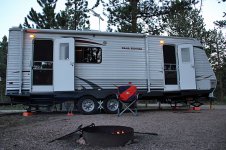We were in your boat just a few years ago - our 34' Elkridge is the first real trailer we've ever towed. Our last RV was a slide-in truck camper. And we're STILL learning how to maneuver this thing (especially backing up)... we do enjoy sitting in the CG watching other "newbies" have the same troubles we do. It's nice to know we're not alone.

A few things we've learned, to date:
1. If your campground offers you expert assistance in getting parked - TAKE IT. We had a guide walk DH step-by-step through backing into a spot... first time, hit it perfect. He knew what he was doing, and it made for a looooow-stress setup (and no yelling between DH and DW, either! HA!)
2. It's REALLY easy to disconnect in a parking lot and then run the truck to the gas station to fill-up... much easier than trying to maneuver the whole rig through tight, busy stations.
3. Backing up - turns start really slow, but then really GO... so get started with as much room as possible, and make small changes. When in doubt, pull forward, straighten out and try again.
4. Pull through spots are TOTALLY worth the extra price!
5. Be PATIENT with your outside guide (DH or DW)... it takes a bit to get your communication signals down. Communicate as much as you need to verbally until you understand the hand signals... Since the key is to turn the BOTTOM of the steering wheel the way you want the BUTT of the trailer to go, I (DW) try to tell DH which way the butt needs to go next. You may opt for a different system.
6. And, as the outside guide - watch BOTH sides of the rig and truck. As you push the trailer one way, the nose of the truck may be aiming straight for a post or hydrant that you can't see across the road.
7. As the outside guide, I'm finding the LESS I talk, the better things go... hmm.... I think that's a good thing. Leaves me free to watch for obstacles, trees, posts, etc.
Enjoy!
I always tell myself, there are LOTS of people driving these beasts around, so why not me? You can do it!

